The Lifestyles of the Trilobites
By Richard Fortey
These denizens of the Paleozoic Era seas were surprisingly diverse
These denizens of the Paleozoic Era seas were surprisingly diverse

DOI: 10.1511/2004.49.446
If you had been able to scuba dive during the Ordovician Period, some 450 million years ago, you would have seen at once that the seas swarmed with trilobites. A few trilobites were as large as dinner plates, many more were the size of modern shrimp, and yet others were smaller than peas.
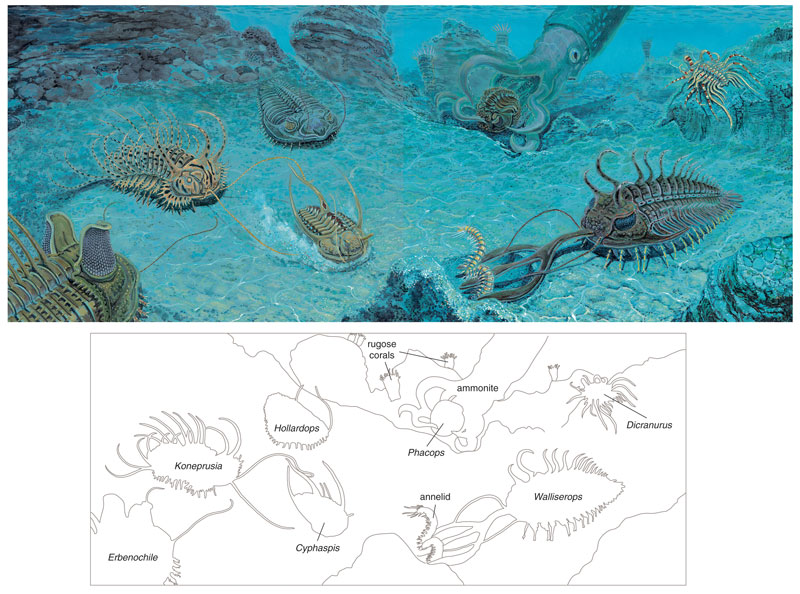
Figure 1 by D.W. Miller; Figure 1a by Tom Dunne.
They lived almost everywhere, from shallow waters to deep environments beyond the reach of light. There were spiny ones like fully laden pincushions and smooth ones looking rather like large pill bugs. Some carried strange colander–like brims, unlike any animal living today. Many had large and obvious eyes; others again were blind.
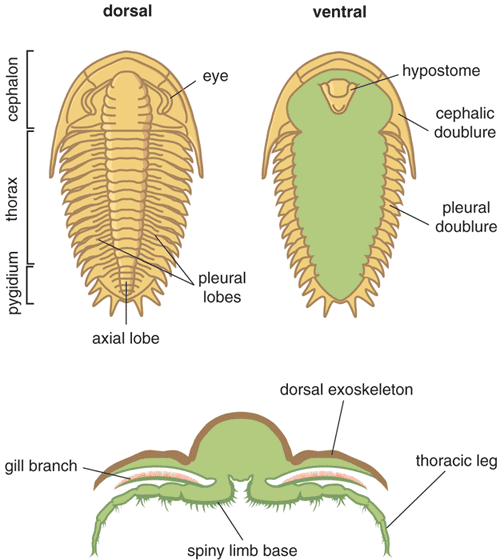
Their wonderful range of shapes suggests that the trilobites must have occupied many different ecological roles. We have a good fossil record of them because they were the first arthropods to secrete a hard exoskeleton made of the mineral calcite. Not that the whole outside of the body was calcified—unlike living crabs and lobsters, the limbs of trilobites never became coated with a calcitic crust. And so fossils of trilobite legs are exceedingly rare. Instead, it was just their backs (their dorsal surfaces) that became covered in a protective shield, which was tucked around the edges of the animal in a fold called the doublure. The three lobes that give trilobites their name comprise a conspicuous (and usually convex) axis flanked on either side by pleural areas, which are turned down laterally. Trilobites are also divided crosswise into a head (cephalon) bearing the eyes, a flexible thorax comprising a number of articulated segments and a tail (pygidium) formed of several fused segments. On this comparatively simple theme the trilobites played a host of variations.
Where trilobite limbs have been preserved in the fossil state it is usually because they were coated with a mineral—such as an iron pyrite or apatite—before they had a chance to decay. The mineral film remained behind after bacteria had destroyed the soft tissue. We know that trilobites had antennae at the front of the head, like many of their arthropod relatives, such as the insects and crustaceans. Behind the antennae, the numerous limbs, arranged in pairs, were all rather similar along the length of the body; a pair of limbs was attached to each thoracic segment. On each limb, a jointed walking leg was overlain by a gill branch, with which the animal breathed. Of the trilobite limbs that have been found, all were built to this basic pattern. So it is likely that much of the extravagant variety in trilobite design was played out upon the hard calcite of the exoskeleton. Abundant fossils give us a good idea of the variety of form adopted by these extinct animals.
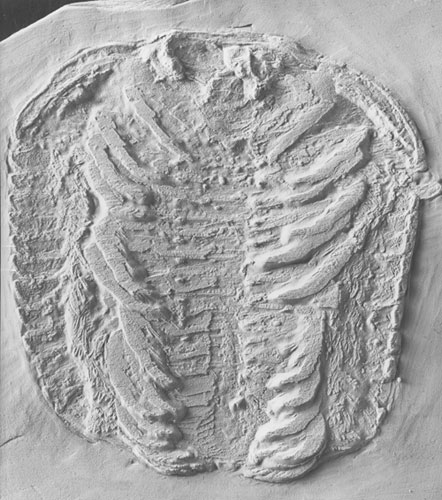
Trilobites appeared rather suddenly in the fossil record, low in Cambrian strata laid down about 522 million years ago. Within a few million years the trilobites were both abundant and varied. More than 5,000 different genera have now been named, and doubtless many more remain to be discovered. They ultimately died out about 270 million years later, near the end of the Permian period, during the "great extinction" that wiped out 95 percent of all species in the Earth's oceans. They could not have survived so prolifically for so long had they not been well adapted for life in the Paleozoic seas. It is important to understand what these adaptations might have been if we are to build a picture of life in the early marine biosphere. But how can one reconstruct the lives of organisms that have been extinct for several hundred million years?
This is not an impossible task, but we must acknowledge that we will never know for sure that we are right about our deductions. There are several ways of going about the science. We might, for example, look among the living fauna to see if there are arthropods with distinctive structures that are similar to those of a particular trilobite. The similarity might suggest that they shared similar life habits. Or we might examine the structure of the trilobite as a piece of biological engineering to see what the animals could and could not do. Then, too, the geological strata in which the fossils are found can tell us much about the habitat the trilobites formerly occupied. Were they living in deep water? Or were they adapted to life on a reef? In fortunate cases, different lines of evidence all point to the same conclusion, and we can be confident that we are converging on some truth about these organisms.
The eyes can tell us much about an animal's life habits. But since these structures are often made of soft tissues, they are rarely present in the fossil record. Not so for the eyes of trilobites. Comparable in some respects to the compound (multi–lensed) eyes of many living arthropods, trilobite eyes differed from those of all their living (if distant) relatives in having lenses made of calcite—they recruited the hard mineral of their exoskeleton for optical purposes. While calcite preserves well in the fossil record, making it a boon for the optically inclined paleontologist, it also provided some perks for trilobites. These animals exploited the peculiar property of calcite that allows light to pass unrefracted along one of the mineral's crystallographic axes. This optical axis was aligned normal to the surface of each lens, so we can deduce the direction in which a given trilobite lens was looking.
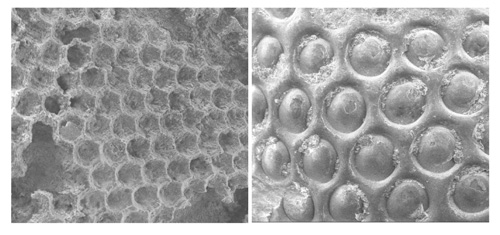
Most trilobite eyes had many, even thousands, of tiny hexagonal lenses (called holochroal eyes), which could register small movements as first one, and then a neighboring, lens was stimulated. A plot of their field of view shows that most trilobite eyes looked laterally—in other words, over the sediment surface on which the bottom–dwelling animal lived. Another type of trilobite eye (called schizochroal) had fewer, larger, biconvex lenses separated by baffles. These lenses were highly sophisticated; they even had internal variations in their refractive index to correct for such optical problems as spherical aberration. These, too, had predominantly lateral fields of view. In some species the eyes were fantastically modified as tower–like structures. These were capable of seeing accurately over long distances since the optical axes are parallel to one another. One species, recently described, even had a kind of eye–shade overhanging the visual surface to keep out distracting light rays from above.
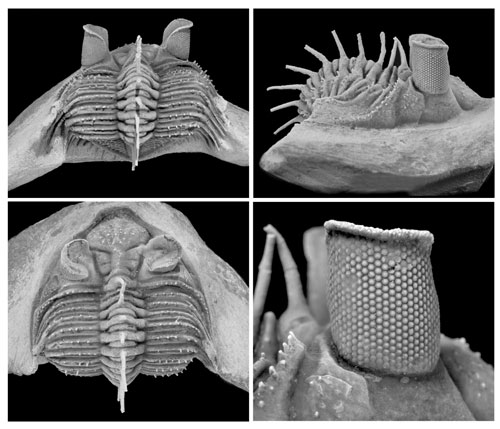
Many trilobites secondarily lost their eyes, and it has been shown that this happened several times in the history of the group. Field studies on their geological occurrence show that some of these blind species probably lived at considerable depths, below the photic (sunlit) zone, where eyes were often redundant. It has been shown that the loss of vision was progressive among some of these deep–water inhabitants, with the gradual loss of lenses until the visual area became sealed over. There is no known example where eyes, once lost, were regained.
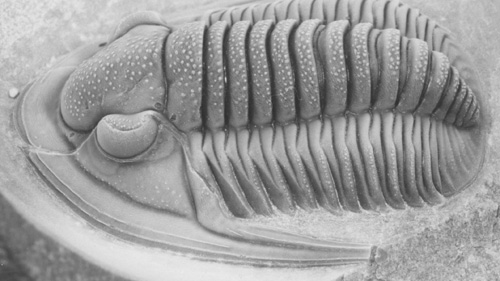
At the other extreme, there were a few trilobites in which the eyes became enormously enlarged. In some species these huge eyes became quite globular, with lenses distributed over the whole visual surface. It is obvious that these species had a more comprehensive field of view than the average trilobite, since the lenses faced forward, upward, downward, even backward—giving the animal almost 360–degree vision. In 1975, I described an extreme version of these animals—named Opipeuter, "one who gazes"—which was discovered in the Ordovician rocks of Spitsbergen. These trilobites were peculiar in other ways too. They tended to have smallish elongate bodies, and the lateral pleurae on the thorax were much reduced, although they seem to have retained strong musculature. Some species had spines on the head which are directed downward. Since this is hardly a sensible adaptation for a bottom–dwelling animal, it seems likely that these trilobites were pelagic, swimming actively in the open ocean. They economized on the weight of the exoskeleton by truncating their lateral regions, while most of the lateral parts of the head were occupied by huge eyes. There are living amphipod crustaceans with similar habits, and they too have hypertrophied eyes. Pelagic trilobites were particularly common in the Ordovician period, when they may have occupied some of the niches inhabited today by krill. Some of these species are extremely widespread, far more so than any of their bottom–dwelling contemporaries. My colleague Tim McCormick and I recently analyzed the morphology of one of these Ordovician species, Carolinites genacinaca, in different parts of the globe. We concluded that the same species was found in what is now the United States, the Arctic, Siberia, Australia and China—a range spanning the entire equatorial realm at the time. This kind of distribution is also matched by some species of living planktonic animals. The species Carolinites genacinaca represents an example in which the animal's functional morphology, its geologic distribution and the comparisons with living fauna all point to a pelagic way of life.
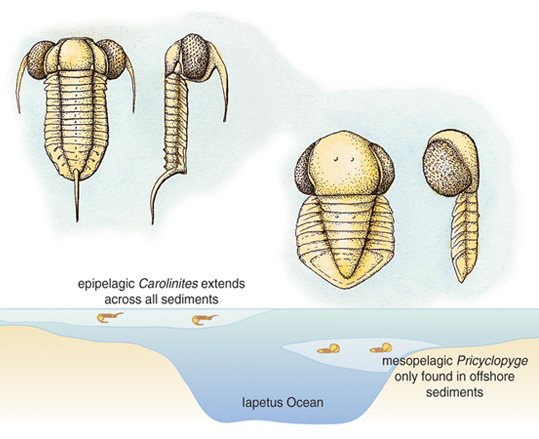
However, some other strange, large–eyed trilobites may have lived at some depth in the water column rather than near the surface. Cyclopygid trilobites are bug–eyed forms that were generally wedded to a deep–water habitat, probably below 200 meters. They are often found in the company of blind trilobites that lived on the seafloor in deep waters, within sediments that accumulated at the edges of former continents or deep shelf sites. Studies of the eyes of these trilobites show that they are comparable to those of modern insects and crustaceans that live in dim light. So it seems likely that cyclopygids were animals of the mesopelagic region, the "twilight zone" just below the ocean's photic zone, and their remains accumulated in death alongside bottom–living trilobites that had lost their eyes. Curiously, a few of these deep–water pelagic animals had square lenses, rather than the more–typical hexagonal ones, for reasons that have yet to be explained.
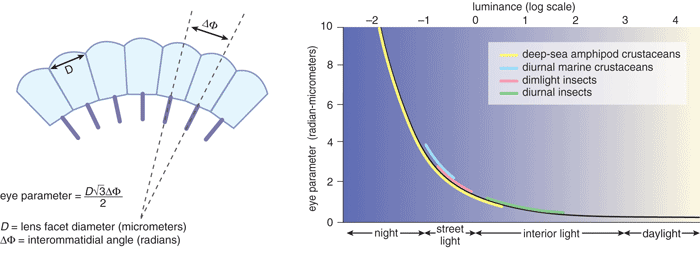
Most pelagic trilobites were rather poorly streamlined, and it is unlikely that they swam very fast. Alongside them there are a few, larger trilobites, such as Parabarrandia, which have a smoothed–out profile, with the head end prolonged into an elongate "nose," somewhat in the fashion of some modern, small sharks. These larger trilobites are modified into a hydrofoil shape, which probably helped them to swim much faster than their smaller contemporaries. Although it seems likely that the smaller, swimming trilobites fed on phytoplankton and zooplankton, it is possible that these larger species were predators on some of the earliest crustaceans. The trilobites appear to have been capable of occupying several niches, even in the pelagic realm.
The vast majority of trilobites lived on or around the seafloor. They never seem to have invaded freshwater habitats—maybe if they had, there might still be species alive today. These bottom dwellers vary from tiny species, which reached mature size at just over a millimeter, to giants nearly a meter long. Such widely diverging animals must certainly have had different roles in the Paleozoic ecology. It was once thought that all trilobites were primitive particle feeders, but it is now considered likely that trilobites spanned almost the whole gamut of livelihoods available to living marine arthropods—with the possible exception of parasitism, although even this has been claimed for one group.
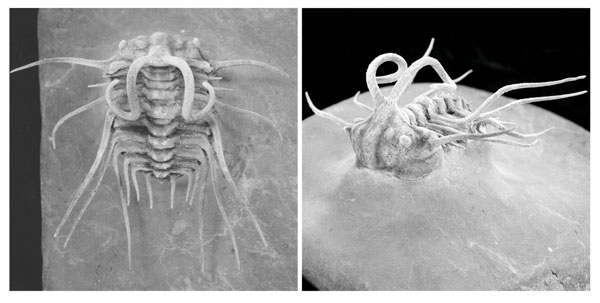
Some trilobites, especially the largest of the tribe, had important roles as predators and scavengers. This is believed to have been the primitive lifestyle for trilobites. Many studies of their phylogenetic relationships place them in a larger clade that includes the stem group of the living arachnoids—of which the horseshoe crab, Limulus, scorpions and spiders are familiar examples. The great majority of this group make a living from scavenging or hunting other animals. Where known, the limbs of the early Cambrian fossils have strong spiny bases that may have been employed in shredding soft–bodied worms and other prey. There are fossil examples where the track of a worm is approached by the track of a trilobite—and the trilobite alone walks away! On the underside of the trilobite head there was a calcified ventral plate called the hypostome. The mouth lay near the posterior end of the hypostome. In predatory trilobites, the hypostome was rigidly braced. Many species developed special structures on the hypostome around the mouth area, such as forks or thickenings. Both features probably helped with the dispatch of bulky prey. A few species even had a kind of rasp on the inside of the fork. A large trilobite must have been a formidable foe to an annelid worm. Its well–developed sight doubtless helped the animal to locate its prey, assisted by chemical sensors on the antennae. These predatory trilobites even left behind their digging traces—called Rusophycus—the imprint of their daily lives on the hunt.
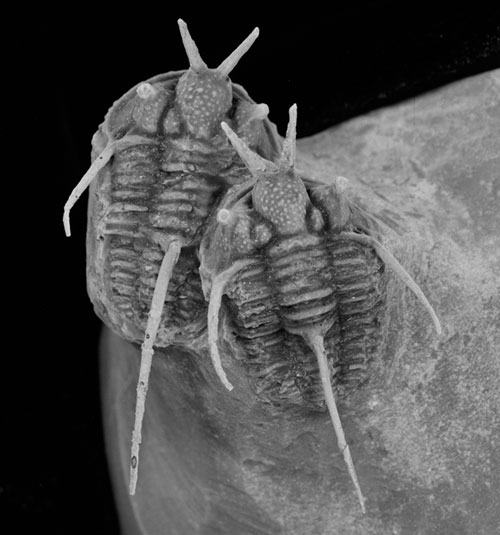
There is plenty of evidence that trilobites were themselves the prey of other animals. They are quite commonly found with what appear to be bite marks—I am tempted to say a "trilo–bite"—but the fact that these are often healed over shows that the attacks were frequently not fatal. The American paleontologists Loren Babcock and Richard Robison showed that in some populations of Cambrian trilobites, bite marks were more frequent on the right side of the animals, suggesting that they were prey to an organism with a ritualized plan of attack. As to the attacker, it is likely that other arthropods were the culprits in some cases. The gut of a Cambrian enigmatic arthropod has been found filled with the mangled remains of tiny agnostid trilobites. The comparatively huge and spectacularly be–clawed, lobster–sized "proto–arthropod" Anomalocaris, first described from the famous Burgess Shale, may have been the tiger of the Cambrian seas, and was also equipped with good, if uncalcified, eyes. By the Ordovician, the list of potential predators is augmented with nautiloid mollusks and, by the Devonian, with jawed fish. It is tempting to see the proliferation of spectacularly spiny and prickly trilobites at this time in certain parts of the world as a response to an increasingly precarious existence by the later Paleozoic. When some of these trilobites rolled up, their spines poked out in all directions, making them a risky mouthful.
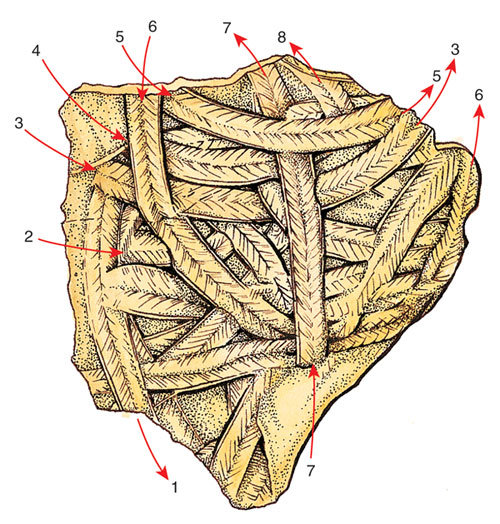
Altogether less showy, many trilobites were small animals, only a centimeter or two long, which scuttled over muddy seafloors often in the thousands. A quarry located in the Middle Cambrian strata of Utah has been "mined" for a little trilobite of this kind called Elrathia kingi; it can be found as small "medallions" in museum shops around the world. With a flattened shape, and often with large numbers of thoracic segments, these animals were seafloor dwellers that retained a broadly similar morphology for more than 200 million years. They were a successful, if conservative, design.
Such small trilobites have hypostomes that are not rigidly attached at the front, so they were supported by a flexible ventral membrane. Such a hypostome may have worked as a kind of scoop, helping the ingestion of soft sediment, from which organic particles could be extracted. The same trilobites have left grazing traces that look like braided tire–tracks (called Cruziana semiplicata) as they plowed their shallow furrows through the sediment surfaces. Some species even seem to have adopted particular feeding techniques, like circling around and around, to efficiently graze the sediments.
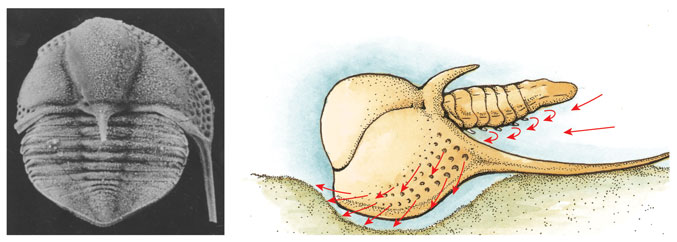
Several groups of trilobites, closely related to particle feeders, adopted a peculiar life habit in environments that were low in oxygen. The rocks that were deposited in this dysaerobic habitat include sulfide–rich black shales and limestones—the latter sometimes referred to as "stinkstones" because of the unpleasant sulfurous odor they emit when broken with a hammer in the field. The trilobites in question, especially those belonging to the family Olenidae, had a very thin exoskeleton in relation to their size. Many of them probably had rather feeble muscles and were sluggish bottom–dwellers. But, in complete contrast to the pelagic trilobites, they had wide, flat lateral (pleural) areas and numerous thoracic segments. This allowed for the extension and multiplication of their gill branches, and presumably helped in coping with low oxygen tension.
There are many examples in the living fauna where specialists in low–oxygen habitats survive and prosper by entering into a symbiotic relationship with colorless sulfur bacteria. These animals "farm" the bacteria, which serve as a nutritious food source. Some clams grow the bacteria in modified gills and absorb nutrients from them directly. It seems plausible that some of the trilobites that lived in oxygen–depleted environments had adopted similar life habits, thus taking the symbiotic relationship with sulfur bacteria all the way back to the Cambrian period. These kinds of trilobites can be found in great numbers when conditions were just right. Usually no more than one or two species are found together, covering the rock surfaces in "graveyards"—and normal trilobites were absent. A few species of this kind also have degenerate hypostomes, suggesting that they may have been able to absorb bacterial nourishment directly from their gills. Even more specialized trilobites of this general kind developed spectacular inflated bulbs on the front of the cephalon. These bulbs may have functioned as brood pouches to help their larvae through the early stages of life, until they were big enough to acquire their own symbionts.
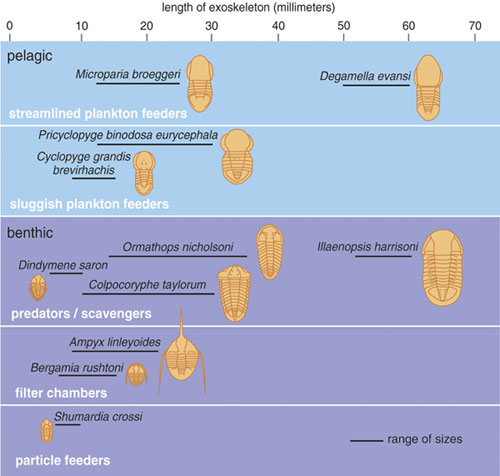
Illustration by Emma Skurnick, adapted from Fortey and Owens 1999.
Another group of bottom–living trilobites developed extraordinary brims around the front of the head, which do not correspond to anything seen in any living arthropod. In many species, these brims are covered with small pits, and they are linked by a fine canal to opposing pits arising from the doublure and the dorsal surface. The brims are frequently extended backwards into long spines alongside the thorax, so that the animal could clearly rest gently on the sediment surface supported by its margin. It is a puzzling adaptation, but obviously a successful one because an Ordovician family of trilobites (the trinucleids) with this design are often found in enormous numbers. Some hint of what the design was for can be gleaned by looking at the animal sideways. The thorax was held well above the sediment surface, so that there was a chamber beneath the animal, flanked on either side by the broad spines. The hypostome (and therefore the mouth) was held well above the sediment surface. It seems very likely that these trilobites lived by stirring sediment up into suspension and filtered out edible particles from the muddy cloud. If this idea is correct, these little trilobites would have had to "hop" from one patch to another to stir up another feed. This is supported by the discovery of traces exactly matching the resting profile of the trilobite, each one with a pair of scoops recording the action of the limbs. One can even see where the trilobites shifted from one patch to another in search of better sediment.
The Paleozoic seas swarmed with trilobites with all manner of life habits: Many large species crawled over the seafloor in pursuit of prey, using their great visual acuity; hordes of others stirred up the sediment to filter out edible particles, while nearby another group of species plowed through the surface layers in search of food. We are beginning to understand how a group of animals sometimes regarded as "primitive" were actually sophisticated and varied. Had it not been for the Permian extinction event they might be with us still.
Click "American Scientist" to access home page
American Scientist Comments and Discussion
To discuss our articles or comment on them, please share them and tag American Scientist on social media platforms. Here are links to our profiles on Twitter, Facebook, and LinkedIn.
If we re-share your post, we will moderate comments/discussion following our comments policy.